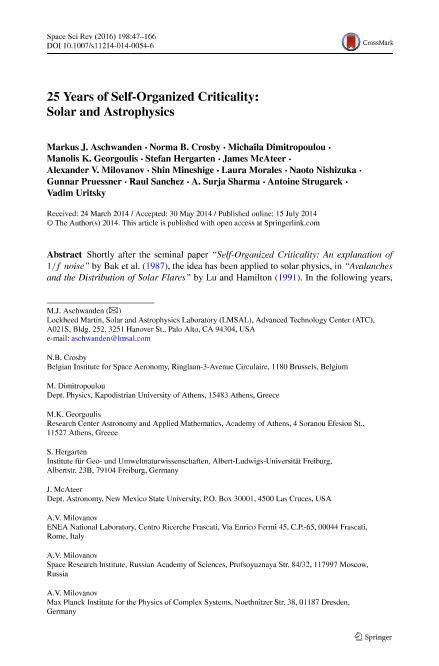Mostrar el registro sencillo del ítem
dc.contributor.author
Aschwanden, Markus J.

dc.contributor.author
Crosby, Norma B.

dc.contributor.author
Dimitropoulou, Michaila

dc.contributor.author
Georgoulis, Manolis K.

dc.contributor.author
Hergarten, Stefan

dc.contributor.author
McAteer, James

dc.contributor.author
Milovanov, Alexander V.

dc.contributor.author
Mineshige, Shin

dc.contributor.author
Morales, Laura Fernanda

dc.contributor.author
Nishizuka, Naoto

dc.contributor.author
Pruessner, Gunnar

dc.contributor.author
Sanchez, Raul
dc.contributor.author
Sharma, A. Surja

dc.contributor.author
Strugarek, Antoine

dc.contributor.author
Uritsky, Vadim

dc.date.available
2017-06-05T16:00:50Z
dc.date.issued
2016-01
dc.identifier.citation
Aschwanden, Markus J.; Crosby, Norma B.; Dimitropoulou, Michaila; Georgoulis, Manolis K.; Hergarten, Stefan; et al.; 25 Years of Self-Organized Criticality: Solar and Astrophysics; Springer; Space Science Reviews; 198; 1; 1-2016; 47-166
dc.identifier.issn
0038-6308
dc.identifier.uri
http://hdl.handle.net/11336/17486
dc.description.abstract
Shortly after the seminal paper “Self-Organized Criticality: An explanation of 1/fnoise” by Bak et al. (1987), the idea has been applied to solar physics, in “Avalanches and the Distribution of Solar Flares” by Lu and Hamilton (1991). In the following years, an inspiring cross-fertilization from complexity theory to solar and astrophysics took place, where the SOC concept was initially applied to solar flares, stellar flares, and magnetospheric substorms, and later extended to the radiation belt, the heliosphere, lunar craters, the asteroid belt, the Saturn ring, pulsar glitches, soft X-ray repeaters, blazars, black-hole objects, cosmic rays, and boson clouds. The application of SOC concepts has been performed by numerical cellular automaton simulations, by analytical calculations of statistical (powerlaw-like) distributions based on physical scaling laws, and by observational tests of theoretically predicted size distributions and waiting time distributions. Attempts have been undertaken to import physical models into the numerical SOC toy models, such as the discretization of magneto-hydrodynamics (MHD) processes. The novel applications stimulated also vigorous debates about the discrimination between SOC models, SOC-like, and non-SOC processes, such as phase transitions, turbulence, random-walk diffusion, percolation, branching processes, network theory, chaos theory, fractality, multi-scale, and other complexity phenomena. We review SOC studies from the last 25 years and highlight new trends, open questions, and future challenges, as discussed during two recent ISSI workshops on this theme.
dc.format
application/pdf
dc.language.iso
eng
dc.publisher
Springer

dc.rights
info:eu-repo/semantics/openAccess
dc.rights.uri
https://creativecommons.org/licenses/by-nc-sa/2.5/ar/
dc.subject
Cosmic Rays
dc.subject
Instabilities
dc.subject
Methods: Statistical
dc.subject
Planets And Satellites: Rings
dc.subject
Stars: Flare
dc.subject
Sun: Flare
dc.subject.classification
Astronomía

dc.subject.classification
Ciencias Físicas

dc.subject.classification
CIENCIAS NATURALES Y EXACTAS

dc.title
25 Years of Self-Organized Criticality: Solar and Astrophysics
dc.type
info:eu-repo/semantics/article
dc.type
info:ar-repo/semantics/artículo
dc.type
info:eu-repo/semantics/publishedVersion
dc.date.updated
2017-06-05T14:47:39Z
dc.journal.volume
198
dc.journal.number
1
dc.journal.pagination
47-166
dc.journal.pais
Alemania

dc.journal.ciudad
Berlín
dc.description.fil
Fil: Aschwanden, Markus J.. Lockheed Martin Corporation; Estados Unidos
dc.description.fil
Fil: Crosby, Norma B.. Belgian Institute For Space Aeronomy; Bélgica
dc.description.fil
Fil: Dimitropoulou, Michaila. University Of Athens; Grecia
dc.description.fil
Fil: Georgoulis, Manolis K.. Academy Of Athens; Grecia
dc.description.fil
Fil: Hergarten, Stefan. Universitat Freiburg Im Breisgau; Alemania
dc.description.fil
Fil: McAteer, James. University Of New Mexico; Estados Unidos
dc.description.fil
Fil: Milovanov, Alexander V.. Max Planck Institute For The Physics Of Complex Systems; Alemania. Russian Academy Of Sciences. Space Research Institute; Rusia. Enea Centro Ricerche Frascati; Italia
dc.description.fil
Fil: Mineshige, Shin. Kyoto University; Japón
dc.description.fil
Fil: Morales, Laura Fernanda. Canadian Space Agency; Canadá. Consejo Nacional de Investigaciones Científicas y Técnicas; Argentina
dc.description.fil
Fil: Nishizuka, Naoto. Japan National Institute Of Information And Communications Technology; Japón
dc.description.fil
Fil: Pruessner, Gunnar. Imperial College London; Reino Unido
dc.description.fil
Fil: Sanchez, Raul. Universidad Carlos Iii de Madrid. Instituto de Salud; España
dc.description.fil
Fil: Sharma, A. Surja. University Of Maryland; Estados Unidos
dc.description.fil
Fil: Strugarek, Antoine. University Of Montreal; Canadá
dc.description.fil
Fil: Uritsky, Vadim. Nasa Goddard Space Flight Center; Estados Unidos
dc.journal.title
Space Science Reviews

dc.relation.alternativeid
info:eu-repo/semantics/altIdentifier/url/http://link.springer.com/article/10.1007/s11214-014-0054-6
dc.relation.alternativeid
info:eu-repo/semantics/altIdentifier/doi/http://dx.doi.org/10.1007/s11214-014-0054-6
Archivos asociados
